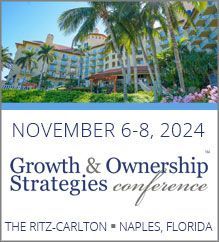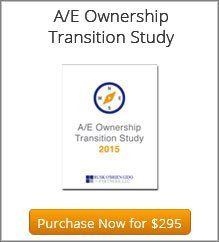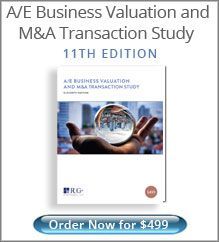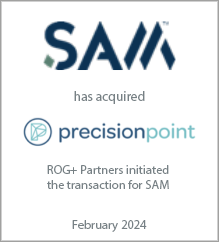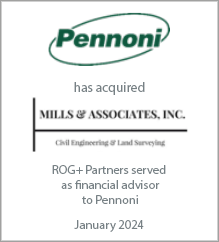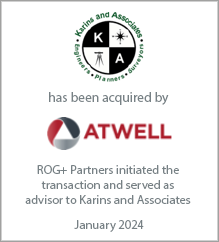Steve Gido specializes in corporate financial advisory services with a focus on mergers and acquisitions. Steve has assisted architecture, engineering, environmental consulting and construction firms of all sizes across North America achieve their growth or liquidity goals through successful mergers & acquisitions. Steve has over 15 years of investment banking experience and holds the chartered financial analyst (CFA) designation from the CFA Institute.
Reigniting Your Firm’s Growth – Mission Impossible?
Reigniting Your Firm’s Growth – Mission Impossible?
June 16, 2011
In our discussions with A/E and environmental consulting Presidents and Principals across a variety of disciplines and sizes, the overwhelming response to our question of “What’s your biggest organizational challenge today?” is a quick and straightforward: “Growing our firm again.”
Compare that answer to the biggest issues facing the design and construction industry just a few years ago. Back then overstressed executives declared to us, “We just can’t find enough people,” and “I’m not sure how we’re going to get all this work done.” My how times have changed.
And while recruiters we talk to say they are busier than ever trying to find those elusive “right people” for organizations short on emerging leaders. And business development professionals are networking and selling their firm’s capabilities more than ever, it still feels like proposals and projects have been coming in dispiriting fits and starts. Mega projects seem to be fewer and far between, and bankers are only now dipping their toes back into selective construction lending again. A sign of the times, state and local agencies are facing headwinds of tighter budgets and austerity measures. Competition for work is as fierce as we can recall, with larger firms chasing down smaller projects and practically every A/E and environmental firm is taking on lower margin work just so their “loyal” clients won’t think twice of using another design or consulting firm!
It was recently reported that economists believe it could take almost four more years for the construction industry to fully recover from the housing bubble and lingering recession. As a result, many A/E firms are trying to position themselves in growing, or resilient, markets (such as green building, energy, shale development, industrial, compliance, etc.) by any means necessary. Many leaders apologetically tell us their short-run growth and business planning exercise has been boiled down to one slogan: “We’re chasing the money.”
In this economic and design climate where we can’t rely on a broad based recovery (yet!) to lift the tide once again, many A/E leaders now realize that growth will come from taking market share away from others and/or penetrating new markets and clients. And more often than not, acquisitions are a faster way to accomplish that goal.
Serial buyers, as well as first time acquirers, have been stirring again. They are on the prowl for small to mid-size targets that immediately bolster their top line rather than risk the opportunity cost of patiently cold-starting offices (add to that the cold reality that many professionals can’t readily sell their houses and relocate to open a new branch office anyway). Small to mid-size firms, particularly in architecture, continue to evaluate regional mergers for scalability and survivability.
Compare that answer to the biggest issues facing the design and construction industry just a few years ago. Back then overstressed executives declared to us, “We just can’t find enough people,” and “I’m not sure how we’re going to get all this work done.” My how times have changed.
And while recruiters we talk to say they are busier than ever trying to find those elusive “right people” for organizations short on emerging leaders. And business development professionals are networking and selling their firm’s capabilities more than ever, it still feels like proposals and projects have been coming in dispiriting fits and starts. Mega projects seem to be fewer and far between, and bankers are only now dipping their toes back into selective construction lending again. A sign of the times, state and local agencies are facing headwinds of tighter budgets and austerity measures. Competition for work is as fierce as we can recall, with larger firms chasing down smaller projects and practically every A/E and environmental firm is taking on lower margin work just so their “loyal” clients won’t think twice of using another design or consulting firm!
It was recently reported that economists believe it could take almost four more years for the construction industry to fully recover from the housing bubble and lingering recession. As a result, many A/E firms are trying to position themselves in growing, or resilient, markets (such as green building, energy, shale development, industrial, compliance, etc.) by any means necessary. Many leaders apologetically tell us their short-run growth and business planning exercise has been boiled down to one slogan: “We’re chasing the money.”
In this economic and design climate where we can’t rely on a broad based recovery (yet!) to lift the tide once again, many A/E leaders now realize that growth will come from taking market share away from others and/or penetrating new markets and clients. And more often than not, acquisitions are a faster way to accomplish that goal.
Serial buyers, as well as first time acquirers, have been stirring again. They are on the prowl for small to mid-size targets that immediately bolster their top line rather than risk the opportunity cost of patiently cold-starting offices (add to that the cold reality that many professionals can’t readily sell their houses and relocate to open a new branch office anyway). Small to mid-size firms, particularly in architecture, continue to evaluate regional mergers for scalability and survivability.
So if your organization is contemplating the M&A path to spur growth, here are some key objectives and strategies one should be mindful of in putting a successful combination together:
- Culture Compatibility – Buyers need to focus their energies on finding targets where the people, philosophies, and processes are a natural fit with theirs. Sometimes that comes with the historical familiarity of a regional competitor, in other cases it’s executives talking and courting multiple firms for comparison purposes. Is the culture “hard-charging and autocratic” or “collaborative and collegial?” There’s a big difference. Understand what makes a target firm unique, including why valued and repeat clients use their design services and why employees enjoy working there.
- Minimize Valuation – Now there’s a fine line with dealmaking in terms of getting a reputation for a “low-baller” or “tire kicker” and simply minimizing the price it takes to close the transaction. Acquisition teams often talk themselves into justifying higher price demands by the seller’s owners, thinking there are more synergies than really exist. Keep in mind M&A is ultimately a capital allocation exercise and that a favorable ROI or shorter payback period is contingent on fair market value vs. other internal investment opportunities. Utilize valuation experts to help calculate a sensible range.
- Match Consideration to Objectives – Buyers typically have at their disposal a range of funding mechanisms, including cash, installment notes, stock, and earnouts. Some A/E acquirers eschew using their own stock as currency, particularly if it trades at book value or some discount to fair market, potentially diluting their own shareholders. Others dislike using earnouts, or pay for performance contracts, as it can often create an “us vs. them” mindset and a disincentive to collaborating together. Be creative and flexible and make sure you are creating some form of incentives for key employees.
- Avoid Assumption of Liabilities – This objective might simply be unrealistic if the transaction is structured as a stock purchase; however, many small deals are structured as asset purchases. In those scenarios, the advantage lies with the buyer, as they are able to pick and choose which assets and liabilities they wish to assume, typically leaving known and unknown liabilities with the seller. In addition, it’s important to skillfully negotiate the amount and enforceability of indemnity provisions.
- Strive for Exclusivity – Buyers typically do not like getting into “auction-like” courtship and bidding contests with a seller and attempt to avoid that type of competition as much as possible. Many try to get around that by requesting a quick turnaround on term sheets before they expire and having binding no-shop provisions in the letter of intent.
- Understand the Sellers’ Motivations – It’s absolutely critical for A/E buyers to understand the real reasons why the owner(s) are selling. Is it due to a failure or breakdown with internal ownership or leadership succession? Are there health issues with the owner or are they just looking to slow down? Do they need access to deeper managerial, recruiting and financial resources to continue to grow? Can these entrepreneurial owners, many of whom have run their own firm for years, now thrive in a larger organizational context, oftentimes with more formalized procedures, policies, bureaucracy and chain of command?
- Harmonious Integration – The integration is where all the courtship, negotiation, planning and diligence now becomes either make or break. Preserving the value of the seller and minimizing business disruptions should be the acquirer’s primary goals. The retention of key clients, management, staff, and contracts is what it’s all about. Otherwise, why go through the exercise at all?
The path to success in an acquisition program is to have a viable pipeline of numerous target firms that meet your M&A criteria and then actively engage with them in a manageable and efficient manner. Our experienced team has led the efforts and processes of dozens of A/E and environmental M&A acquisition programs and buyside engagements over the years.
Latest Perspective
Perfecting the A/E Exit Strategy – Five Key Factors
An enormous A/E generation that kicked off their careers in the 1980s and subsequently started firms or became owners in the 1990s ...
© 2024
Rusk O'Brien Gido + Partners, LLC
Financial Experts for Architects, Engineers, and Environmental Consulting Firms


